Jay’s Audio CDT-2Mk2 and DAC-2 Signature
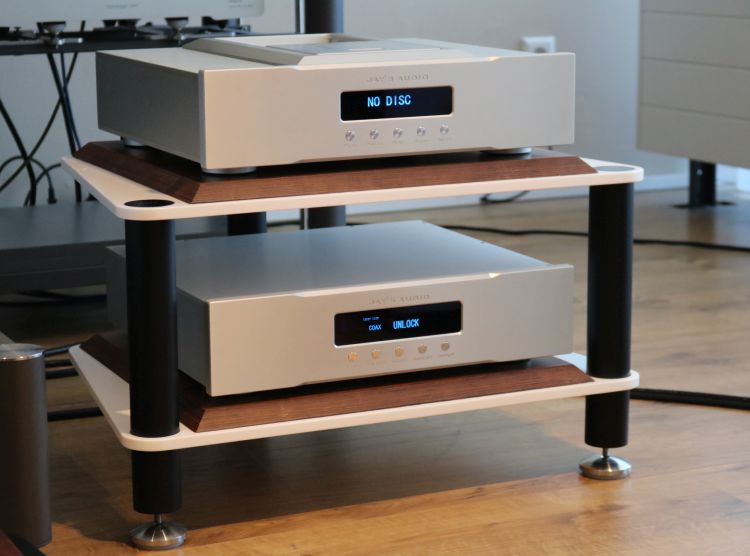
Music Server input
Switching from the CD transport via I2S on HDMI to the Antipodes CX+EX combo via USB, the sound becomes even tauter and more impactful with undiminished PRaT and remaining full-bodied and sonorous. This strong rhythmic aspect is present with the DAC-2 Signature no matter which input is used. In a direct comparison with the CD transport, the latter consistently sounds sweeter and more relaxed and considerably more fluid than the server. The sound via USB is little drier and less free-flowing and, perhaps less immediately pleasing than the CD transport’s presentation. Of course, a digital format does not differentiate between frequencies. So, the free-flowing fluidity that is so very pleasant in the treble and midrange is also present in the bass and there, it is arguably less welcome. Indeed, the transport’s bass is slightly rounded compared to the USB input. It seems fair to say that the server’s delivery is probably more accurate. This is particularly evident in the bass, which with the DAC-2 and modern R&B is as tight and explosive as I’ve ever heard it. The CX+EX combo has been my favorite server for a long time, precisely for its full-bodied and solid delivery and the Jay’s DAC certainly plays to this server’s strengths. When playing CDs, however, the sound washes over you more easily and you tend to forget about the technical aspects more quickly. Somehow, it remains easier to become emotionally involved with CD than with ripped music played from a server.
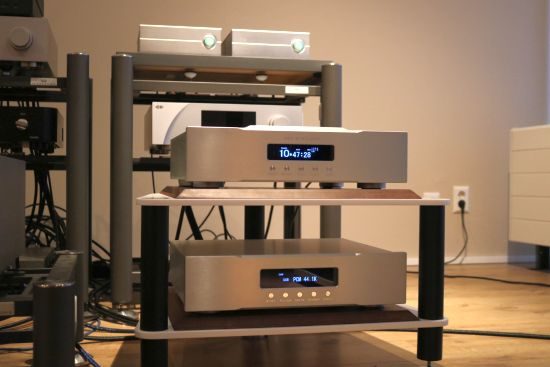
I used the Final Touch Audio Callisto USB cable for the most fluid and free-flowing sound with the Antipodes server and the I2S HDMI cable between CD transport and DAC meaning that the CD transport should hold the best cards for sounding the tightest. That it still sounds more fluid, I think has everything to do with the CDM-4 mechanism. All the other players with this mechanism that I used in the past had a similarly fluid presentation. However, the Jay’s Audio transport clearly deviates from all those classic spinners by retaining the fluidity but also sounding consistently more upbeat and direct to make for a very well-balanced delivery. It seems very likely that this has everything to do with the CDT2-Mk2’s elaborate power supply and its very accurate clock.
I should mention that I have also heard CD transports that are just as tight as the Antipodes or even tighter but without exception, these transports are much more expensive than the Jay’s. Invariably, these use linear mechanisms and in these cases, the overall feeling is also of a drier and more technical sound, much closer to the typical Music Server Sound. Are these mechanisms more accurate or do they lose some “musicality” in the process? I have my suspicions but, regardless, I think that the CDT2-Mk2’s allure is precisely that it sounds so fluid. Ultimately, this very much remains a personal matter – it all depends on the user’s aim.
Whether fed from a CD transport or a music server, the DAC-2 Signature provides the kind of super-enjoyable sound that I have not heard before in this price class. Of course, there will always be differences between CD transports and Music Servers but I find that’s part of the charm. Personally, I never feel like I must choose. I enjoy all formats for different reasons and simply use any format that I fancy at any given time, be it LP, CD, or a file on the Music Server.
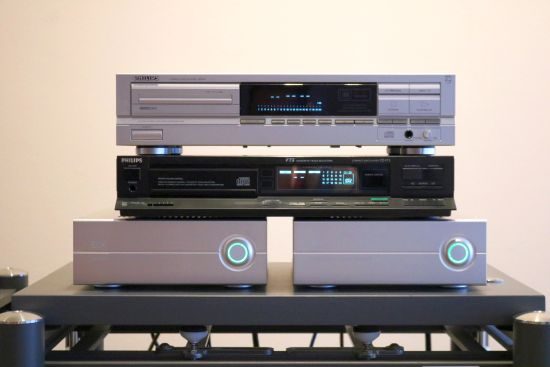
CDM4 = CDM4?
In a direct comparison using a Belden RG59 coax cable with two classic Philips players that use the same CDM-4 mechanism, the Jay’s Audio player’s superiority was evident. The CD473 sounded plasticky, washed-out and even a little edgy and the CD614, always one of my favorite low-cost players, was indeed better than the 473 but still comparatively synthetic in timbre and, just like the other player, lacking focus and incisiveness. In order to make sure the players were judged on equal grounds I placed the CD614 on the same type Artesania Modular rack as the Jay’s Audio CDT2-MK2 was on and, believe it or not, this did help it develop a tonally fuller sound. But the player still sounded comparatively washed-out and rough yet not as propulsive and incisive. Alas, all the attention in the world cannot make a CD614 the equal of the Jay’s Audio transport. Not by a long shot.
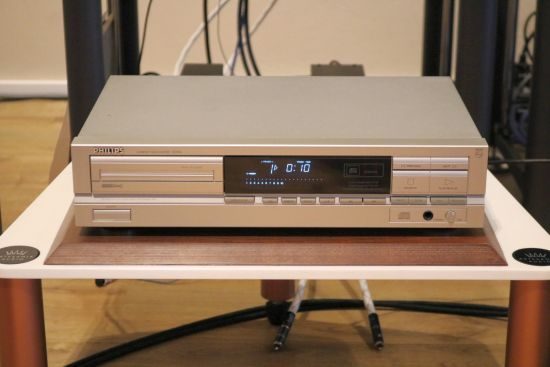
Digital = Digital? Fuhgettaboutit! If there wasn’t a trace of family-resemblance, I would be tempted to pronounce the differences between these two CDM-4-equipped players night and day. But it really is no contest and I think anyone could hear it. No golden ears required. Yes, the difference is that large. Now, one could argue that my trusty CD614 surely must have worn-out capacitors but this unit was completely recapped only a couple of years back, making it very unlikely that it is in any way off-spec. Nope, I think this clearly shows that the Jay’s Audio transport is really excellent.
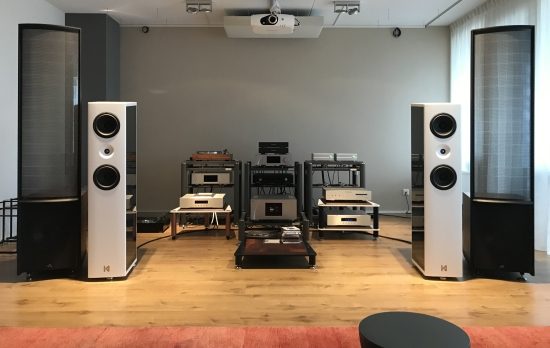
DAC Comparisons
The sound of a D-A converter is a sum of its parts as well as the implementation. So, it could be a coincidence, but I have found that AKM-equipped DACs always sound impactful and upbeat, and indeed, the Jay’s Audio DAC is no exception. Visually, it bears some resemblance to the Esoteric D-07 DAC and from aural memory (which is hugely non-trustworthy, I know), I’d say that it bears some resemblance as well, particularly in terms of its bold and upbeat presentation. A more current DAC that has a similar presentation is the Bryston BDA-3 but I’d have to hear all these DACs side by side to know the precise differences. The biggest difference, of course, is in the price tag.
Using the Antipodes EX and compared directly with the Aqua Formula xHD (at this stage still with the v1 output board), the Aqua has a very different presentation than the Jay’s Audio DAC-2 Signature. Although the Jay’s Audio DAC was set to the NOS filter setting, the Aqua employs discrete R2R arrays and an actual NOS topology but I honestly can’t say that literally everything with the Aqua was better. I mentioned resolution of detail and indeed, the Jay’s Audio DAC does not paint quite as precisely or as subtly as the Aqua DAC. But instead, it has a significantly more energetic and more solid delivery which is absolutely entertaining, especially with the Kromas. Importantly, the Jay’s Audio DAC sounds every bit as natural as the Aqua and timbrally just as convincing. Putting it in as little words as I can, the Jay’s Audio DAC-2 Signature is best described as “full-bodied and taut”, whereas the Aqua Formula xHD’s key descriptors would be “transparent and refined”. Indeed, the Aqua has noticeably higher resolution and it digs deeper into the mix, similar to going from an elliptical stylus to a fine line stylus with a good record player. In audiophile terms, the Aqua is better. Of course, at almost 14K, it is also in a very different price category. And also, one could still argue over which one sounds better or better provokes emotion. What’s for sure is that I find the Jay’s to be hugely involving and an absolute joy to listen to.
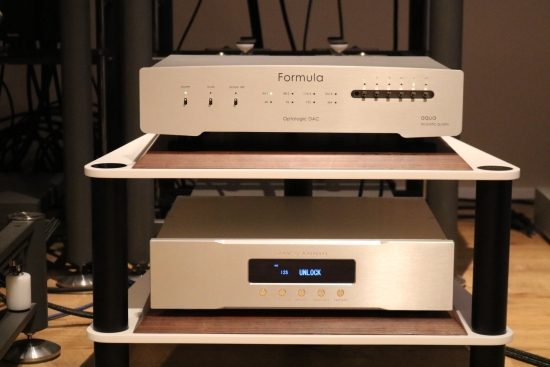
At this point in the review, I moved from the Kroma Carmens to the Martin Logan ESL15A’s, and again with the complete Jay’s Audio CD + DAC combo, only to find that, once again, I am blown away by how great the Jay’s components sound! Audio buddy MP came by and he commented on the fact that he had not heard any Martin Logans sound this convincingly natural yet. He’s a Jadis/Sonus Faber guy and he places a particularly heavy emphasis on tonality. I should also mention that, so far, he had only heard smaller or older Logans with very different equipment at my place but still, it’s telling that he felt this way when the Jay’s Audio components were playing. The Logans have some character of their own but they are also very clean and transparent and any synthetical coloration in the source is immediately heard. Not so in this case, though. The Jay’s units really do sound as neutral and natural as I already thought they did with the Kromas.
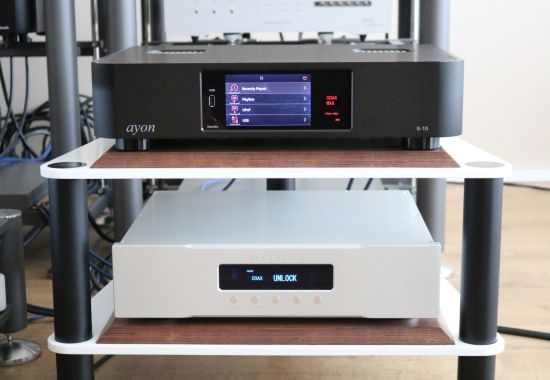
At this time, I also had the Ayon S10-MkII DAC for review. Being a tube-design, one could easily assume that it would sound very different from the Jay’s Audio DAC-2 but imagine my surprise when they two DACs turned out to have more similarities than differences! In terms of bass drive, tonality, harmonic richness, and resolution, the two DACs are very close. Where they differ primarily is in terms of perceived soundstage depth and the feeling of being engulfed by the sound, which the Ayon does indeed do better. This is one of the aspects in which tube products often excel. I should mention that Ayon products, in general, are particularly fast and tight for tube products but you can also say that the Jay’s Audio DAC-2 Signature is remarkably sonorous and richly textured for a transistor design. The decision between the two was also related to what kind of music was played. With rhythm-driven music, I preferred the Jay’s Audio for its tighter and more articulate bass and with smoother music such as soul, I preferred the Ayon for its deeper sound and longer lingering decays. Which of the two should be regarded as being better? Honestly, I could not make that decision. First, we are talking about tube versus transistor and second, they are very similar and choosing between the remaining differences is very much a matter of personal preference. That’s something for every person to decide for himself or herself. All I can add at this point is that the Ayon costs three times as much.
Preliminary conclusion
Both the CD transport and the DAC have much impressed me. Although different presentations can make for certain preferences, meaningfully better transports or DACs can really only be had for amounts nearing the 10K. Both Jay’s components perform at a level for which competing European or American products charge double to triple. Even if certain aspects of their performance can be bettered if enough extra money is spent, the bottom line for me is that these components make music with such involvement and enthusiasm that they immediately instill the desire to play more music, not think about technical matters. I like them so much that I added them to my system and made them my references in the affordable high-end class where they’ll provide stiff competition for any competitors to come.
At this point, I initially concluded the original review but since the Jay’s components have taken permanent residence in my system I have carried out more transport comparisons. You can read all about this on the next page.






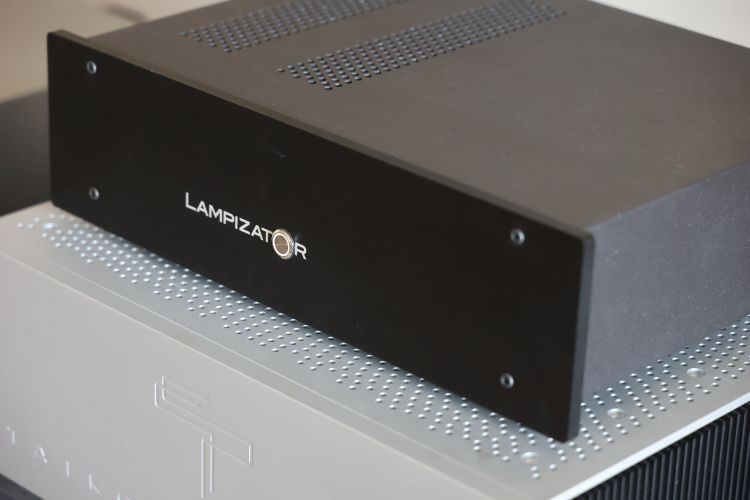
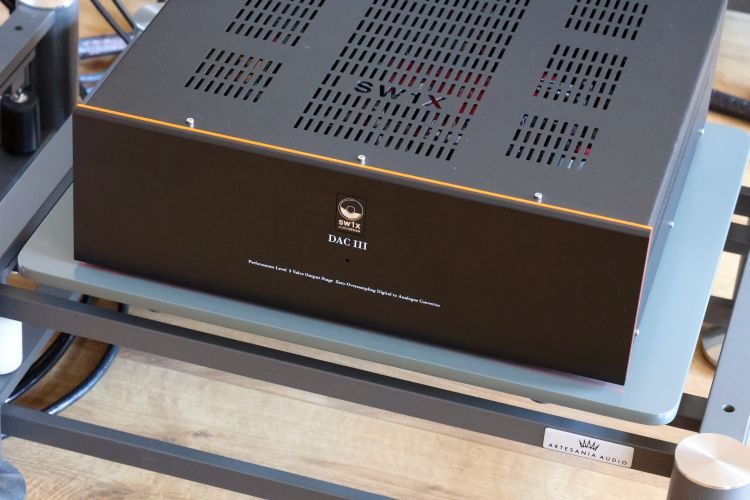
Hi Christiaan,
Sold my jay audio cdt2 which I had for about 7 mths.
If you have the opportunity, please consider having published review of even more cost effective Denafrips Avator with same Philips CDM 4 transport but with clock input as well as more i2s outputs than just single hdmi of the cdt2.
Used with the special order of Denafrips Terminator Plus (replaced my 10 mths old standard Terminator) with oxco clock and synced with the Avator’s clock input, it is endgame of my system in near future with Audible Illusion L3A pre amp, Sanders Magtech amp and Revel Salon 2 speakers for me and back to CD playback last many days and nights.
Btw, many thanks also on the Antipodes which I took the plunge and just received together with local purchase of 2x Samsung EVO 4TB SSD … will soon hear how it performs against the oxco clocked Denafrips Avatar soon.
Cheers.
Richard
Hi Richard, I may well review the Avatar indeed. The unit certainly looks interesting.
I’m curious to hear how you experience the Music Server versus CD player sound. So far, I have not heard a server that truly equals a good CD transport on all accounts. Servers can certainly better CD transport in some aspects but they all do some aspects better than others. It also depends on which CD transport/CD player you compare it to. Antipodes is particularly great in terms of solidity, transient behavior and overall dynamics. All the servers that sounded more fluid or refined also sounded rounded and too mellow for me. It remains interesting why a theoretically inferior format can sound so great.
Hi Christiaan,
Thanks for your quick response and further sharing.
By itself and with the standard Denafrips Terminator, the sgd1.8k Denafrips Avator sounded only a bit better but notably so than the sgd2.6k Jay’s cdt2 mk2 when I bought it.
It is when I installed the Terminator Plus with oxco clock out to the Avatar that the Avator stepped up to a different league from the Jay’s cdt2 mk2.
Furthermore, I am using the Avatar’s i2s output to the Terminator Plus which when compared to aes/xlr output/input was also obviously with wider up/down and left/right staging, clearer/more extended frequencies and cleaner/darker presentation.
Hope this clarifies a bit more but Antipodes via usb without synced clock will be put to task and there is no chance for me to venture to Aurender W20/se with clock input/ouput but I am a converted believer now on what a superior clock especially synced to DAC’s can achieve in sound quality improvement.
Cheers.
Richard
Hi Richard, all clear:-) I’ll keep the clock option in mind.
Hi Christiaan!
Just reading your observation ’bout Jay’s Audio cd transport. Wondering why you didn’ t compare Jay’s transport with Ayon’s?
I believe major thing when listening is synergy between components. I can tell you my example. My setup consist of Ayon S-5 dac/preamp/streamer and I tried few transports (Northstar, Accustic Arts Reference Drive II and Ayon CD-T II).
With Northstar my system was ok, but the sound was not as good as with computer audio. After that I put Accustic Arts transport (12000 €, ouch!) and I was amazed how Accustic Arts put cd reproduction to new dimension way ahead of computer audio reproduction.
And best for the last, Ayon Audio CD-TII (half the price of Accustic Arts), put sound to even greater level. I’m sure it’s because of the synergy between Ayon components…
Oh, btw all three transports had the same Philips Pro II drive, and all sounded different!
Just my observation!
By the way, GREAT blog!!!
Best regards from Zagreb, Croatia, Europe!
Jurica Kosovic
Hi Jurica, Glad you like it! Alas, I can only compare to players that I have available. The CDT-II has returned to the manufacturer long ago. Yes, synergy is a very big thing and this is what I emphasize in nearly every review. Also, I agree that transports can sound very different, even if they use the same mechanism.
Hallo Christiaan,
Hoe verhouden zich kwalitatief de Sony xa50es en de Marantz cd94mk2 tot dit loopwerk van jay? Mvg, jeroen
Linear Sony mechanisms sound very different from Philips swing-arm mechanisms. Please have a look at the Classic Philips/Marantz comparison to read more about this. In short, the XA50ES as a transport sounds lean and tight, a little restrained and timbrally synthetical, ie it does not really sound natural to me. Any CDM1/CDM4-based transport that I tried, even old and worn ones, sound riper, fuller, sweeter and more spacious. Most of them also sound timbrally more convincing. Older ones or ones that have gone off-spec can go overboard in ripeness and become too slow and woolly. Between Jay’s and the CD94 it really depends on how good the CD94’s mechanism and electronics still are. Without a recapping, most of them will by now have gone off-spec. They do this gracefully but become slow and dull in the process. A CD94 in factory condition will sound close to the Jay’s in terms of overall character (fluid, refined and free-flowing) but likely still different due to the difference in the power supply quality, capacitor brands and the quality of the clock crystals.
Hello Christiaan,
I had fun reading your review in 3 episodes, which I found very well done and very informative, well done and thank you! However, have you heard of Denefrips’ Avatar transport cd player which uses a mechanism similar to that of Jay’s Audio? And then there is also the DAC Denefrips Terminator! It could be very interesting a comparison between the two, what do you think?
Looking forward to reading you !
Best Regards
Pascal
Hi Pascal, glad you liked the review. I know of the Terminator and have reviewed the Venus. Indeed, I noticed that Denafrips have a transport similar to the Jay’s but as of yet, there are no plans to review it.
…. … There is also the DAC 300 from the French manufacturer Atoll (2495 € / 2810 $) which could be interesting to test!
Hi Christiaan ,
Thank you very much for your time to respond! Thank you for the link while waiting for a possible review of the Dac Terminator and the CDT of the same brand, which would lead to a duel Denefrips vs Jay’s Audio! Héhé …
Best Regards
Thanks for the great review!! I am looking for a high end (not SOTA) transport that will improve on the already good sound I am getting using the EAR Acute as a transport, but for a reasonable price such as the Jay’s Audio. This is one heavy transport for under $3,000, 15 kg. Does it track burned discs and discs exceeding 80 minutes? Cyrus XT signature transport is about the same price but reportedly is critical of CD quality(?). Reviews of Cyrus are not specific. Also, I noted that there is no pause button. How does one pause during play? Does one have to fast forward or backward to get back to the place one stopped at?
Hi Stephen, I’ve not heard the EAR Acute but it uses a very simple Sony transport and typically a change from a Sony mechanism to a Philips Swing-Arm mechanism yields a sweeter and more liquid sound, as described in the Jay’s review. Philips CDM4’s are extremely reliable and I’ve never found one that did not read a CD. The Jay’s uses a NOS CDM4 mechanism and also reads all the CD’s that I have fed it, including very old CDR’s. Even though the Cyrus does not have a dedicated pause button on its front panel, its play button is a toggle between play and pause. Depending on what it’s doing, its either play or pause. The remote control does have a dedicated pause button.
Hi Christaan,
How does the DAC compare to the Jeff Rowland Aeris?
Honestly, you can’t really compare these products, not only very different sonic presentations but also too big an overall performance gap. Although I have upgraded several times after the Aeris, I still feel that it is a very good DAC. In short: the Jay’s is more like a Wadia: robust, sonorous, a little dark and a little rough. It also bears some resemblance to the Esoteric D-07, the PS Audio PWD MkII and, to a lesser extent, the NWD. The Aeris is much more fluid and refined and is a bit like the Bricasti M1 Classic but a little fuller and sweeter and slightly less highly resolving. It also has some similarity with the Accuphase DC-37 (but the Aeris is actually better, IMHO). There is enough solidity in the Aeris’ bass to satisfy my needs but it’s not entirely up to Wadia standards. The main areas in which the Jay’s differs from the Aeris is that it has more sonorous bass, even more impact, and a more natural timbre.
Maybe you can inform me as to the differences between the Jay’s Audio CDT-2Mk3 (new version) and the Denafrips Avatar which look the same and similar inside but differ in price and some features. My main concern is the pause/continue feature lacking in the CDT2-Mk2 version. I don’t know if the Avatar has the same problem.
Good question. I’ve not seen or used either just yet. I’m not sure what you mean by the pause/continue feature. The CDT-2Mk2 has a pause button and it works as expected. As with normal Philips servo systems, pause means pause and unpause while play means play and replay.
Dear Christiaan,
I happened to be a big fan of your articles / reviews, which I have been reading for past couple of years. Therefore I would really love to know your opinion on two subjects.
I owe the CD transport Jays Audio CDT2 mk2, which I bought roughly half a year before you published your review. I totally agree with everything you wrote and I honestly find your review the most accurate from all the ones Ive read. I even connected digital S/PDIF cable Mad Scientist HDC after reading it, and I can also confirm that the connection with Jays Audio makes it a fantastic digital source. Unfortunately, there is a small catch: there are irregular outages of sound lasting about half a second during playing a CD. I have tried several digital cables and I am unfortunately experiencing this trouble only with Mad Scientist HDC. Have you ever experienced something similar?
I also loved your review on Jorma Design AES/EBU digital cable. I am planning to get in touch with Jorma Design and buy this cable in S/PDIF. I trust everything you wrote in your review, but nevertheless I have a question: could you describe the sound difference between Mad Scientist and Jorma Design? Is Jorma really that good? I would really appreciate your opinion on this matter.
Sincerely,
Jaroslav
Hi Jaroslav, I have heard of instances where a Mad Scientist USB cable does not match with a certain chipset. That’s because it is deliberately made to work outside the strict format specifications, in order to gain a sound-quality advantage. The USB cable parameters can be tweaked by the manufacturer on demand. Not sure if the HDC cable can also be tuned. In any case, do write the manufacturer, just in case.
Just how the HDC and Jorma compare I cannot say right off the top of my head as I never had them side by side and the last time I used the HDC is a long time ago. However, I am expecting a couple of new Mad Scientist digital cables for review shortly.
hi christiaan
any chance that you ‘ll be reviewing a chord dac (qutest, hugo TT2, or Dave) and compare these with this combination or your other (reference) dacs?
Bye, Jeroen
I might do at some point but it’s not yet on the horizon.
Dear Christiaan,
It seems like the discontinued Denafrips Avatar CD transport was a really short-lived product, do you know why?
The buzz now all seems to be about the Jay’s Audio CDT2-MK3 (Philips CDM4/19 mechanism) and the new CDT3-MK3 (Philips CDPro2 mechanism). I thought the CDPro2 was “sold out”. Can Jay’s have acquired a large NOS stock? If you develop a new product based on it, the stock has to be fairly big, I would think for it to make sense.
I hope you get a chance to hear the new CDT3-MK3 and let us know your thoughts.
Best regards,
Per
I tried to get an Avatar review sample but Denafrips ran out of NOS CDM4 mechanisms of which they indicated to have had 4000 pieces. It’s certainly remarkable that they found the supply 30 years after production stopped. Nevertheless, I have removed the CDM4 from my CDT2, studied it up close from all angles, and compared it to the original CDM4’s that I have and I could not find any differences.
I have not heard the Mk3 version of the CDT2.
Given the case of the CDM4 for Yay’s Audio and Denafrips, it is interesting that an Asian company struck gold once again and found a large supply of CD Pro2 mechanisms as they are fast becoming unobtainium. A single NOS CD Pro2 currently costs 1000 euros from Enco, the last remaining source that I am aware of. I guess it’s plausible that these are actually refurbished or newly produced mechanisms. Which is still fine of course, if they operate as intended.
All that said, if a CDT2-Mk3 comes my way, I will certainly review it.
Update 27-04-2022: As a matter of fact, I have just been asked to review the brand new Jay’s Audio Flagship CDT3-Mk3. I took the opportunity to ask about the CD-Pro2 mechanism. Here is the manufacturer’s response: “The CDPro2 LF mechanism is NOS with Jay’s Audio modification. Jay’s Audio stock sufficient units to fulfill the market demands, as well as for future servicing needs.”
Hi Christiaan,
I am deciding between purchasing of this Jays CDT 2mk3/DAC combo and Mark Levinson 390S in very good condition after service. Could you please describe the differences in the sound off the top of your head, is the new combo much further, or can the old 390S be better in some aspects?
Thanks
Jan
Hi Jan, It’s more a matter of personal preference than one of quality. The Levinson is smoother, airier, and more refined, while the Jay’s combo sounds more robust and dynamic.
I had a choice between the two units and spent double for the CDt3 Mk3. It is AMAZING! I’ve had over two dozen various cheaper transports and a PS Audio at an even higher price. No comparison in quality. This is IT! If I couldn’t have bought the CDt3, it would have been the CDt2. I considered several others I haven’t heard, the Aqua and the T&A 2000. My prior favorites used CDM9 transports. It will be paired with a Lampizator Poseidon, currently paired with a radically upgraded Emotiva XDA1 (analog board, no Opamp) which includes 5 Sparkos regulators ($47 each) among the vast power upgrades. For $1000 DAC upgraded and $5,000 transport, finally great digital sound!.
P.S. I have nearly 16,000 CDs (need to cull about 3,500-4,500).
Nice! I thought I had quite a few but 16.000 is something else:-)
Thank you for good advices. And how can you compare sound of the same 16/44 track from CD on Jays CDT3 mk3 +Jays DAC with Grimm MU or Antipodes K server + streamer with the same DAC? Can CDT3 CD transport sounds better than Antipodes or Grimm server?
The Grimm and Antipodes servers are reliant on the SQ of Roon, which, sadly, wavers with every release. When the MU1 was at its best, it was very hard for a CD player to come close or beat it in most areas. But as Roon sounds currently (smooth but blurred/compressed), it can be relatively easily bettered by a good CD transport. However, all servers and CD players have their own character, and “Better”, as you ask, is a relative matter up to the listener. As such, there is no “best” server nor a “best” CD player. My advice is to read my reviews in which I make lots of comparisons, and then make up your own mind.
Hans Beekhuyzen on his YouTube channel extolled the superiority of his Grimm MU1 to any CD playback INCLUDING the Jay’s CDt3 Mk3 (he reviewed). However, his credibility sank when I asked him if he listened to CDs his answer was “I listen to cds after I have ripped them to a hard disk.” Apparently, he also considers his system superior. I can assume from his answer that he does NOT listen to historic recordings of lesser sonic quality such as found on Marston, Romophone or Biddulph labels which mostly deal with vocal, piano and string 78 recordings. There is no streaming of these labels. He did not answer whether I should dump a Lampizator Poseidon DAC/pre-amp and Westminister Labs REI amps for his system and just go with a cheap transport with his Grimm MU1 to achieve sonic nirvana. I’m into music, not audiophilia. I can now afford a high end system for my quite large music collection which I listen to daily for several hours. Plus, apparently only 15% of the streamable music is of CD quality mastering or better. At numerous recent audio shows, my friends and I have experienced many high end systems with bad (not even mediocre) sound that relied on streaming. I say, if one has the CDs, choose the best CD player or separates one can find. My neighbor has 3,000 CDs but uses EAC to his computer and thumbdrives/chips (portable use as well) to listen with a complex electronic system (Berkeley, DAC and other computer equipment) to find and listen to his music. It does sound great on his $1/2 million system but so much work!
I prefer to just pop in a CD. I also listen to LPs and that’s more ritual prior to listening. With the Jay’s, I love CDs as much as analog now. Half of my collection is housed in organized sliding Can-Am steel drawer cases in my adjacent storage room. Just wonderful. Maybe the Grimm is better for “a few” recordings but it would leave out 90% of my collection.
Thank you very much, Christian and Stephen. You are both correct. If I had the biggest CD collection in the world like Stephen, I wouldn’t even ask, I’d already have the CDT3. But I only have 500 pcs, but also a similary large collection of 16/44 and hi-res flacs and dsf. I now have a Lampizator Amber 3 DAC and a Melco N1A/2 streamer. But we tried the Theta Carmen CD transport with the Amber3 and the same recordings sounded more fun and fuller and closer to the reality of the CD, albeit with a little lower resolution and spaciousness. So I looked for CD or CD transport as a solution. But the more I read in the tests and on the forums, and according to Christian’s answers, I finally decided to buy a top streamer. A CD is better than a medium-priced streamer, but the top streamers are further in resolution, fullness, spaciousness and dynamics. So I’ll focus on a selection from Melco N5, Metronome Le Streamer, Fidata HFAS2-X40, Pachanko Constellation SE+ Stellar+Oliospec, Antipodes K22 G4, Grimm MU1, Jcat XACT S1 and LDMS (Taiko Extreme, Pinkfaun 2.16 and Aurender W20SE are too expensive). Which one can have the best sound/price ratio? I demand maximum transparency, fullness, spaciousness and timbre.